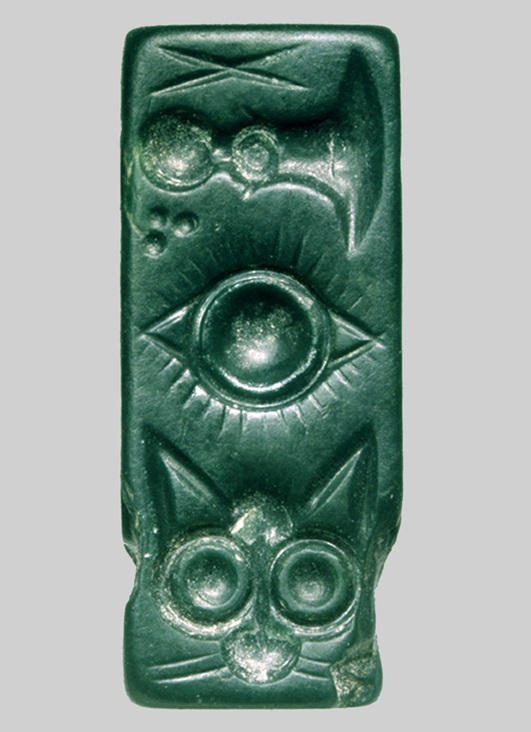I just discovered that it is International Cat Day – which is unusually relevant to my research at the moment! But why should someone who works on ancient writing be so interested in cats all of a sudden? Well, we need to travel back in time to the ancient Aegean to discover the reason.

Cretan Hieroglyphic seal made of carnelian, showing a cat figure. Image from HERE.
The first developed writing system surviving from ancient Crete, from the beginning of the 2nd millennium BC, is one that we call ‘Cretan Hieroglyphic’. It was the archaeologist Arthur Evans who coined the term, based on the fact that the signs look like pictures of real things, animals and objects – but it is not a script of the same type as Egyptian hieroglyphics (on which, see Rob’s recent post), but rather is syllabic like the other Aegean scripts.
One of the signs in Cretan Hieroglyphic is clearly a representation of a cat’s head. We do not have very many examples of the cat’s head sign – but this is not entirely unexpected given that we only have about 300 Cretan Hieroglyphic inscriptions in total, and the ones we do have bear very short inscriptions.

Cretan Hieroglyphic seal made of green jasper, with a cat’s head sign at the bottom. Image from HERE.
The next of the Aegean scripts is one that we label Linear A (again thanks to Arthur Evans’ nomenclature), which appeared soon after Cretan Hieroglyphic and co-existed with it for a long time. Linear A is, as it sounds, more linear-looking and correspondingly somewhat less pictorial-looking. We don’t understand the relationship between Cretan Hieroglyphic and Linear A very well, or the reason why they were both in use at the same time.
Linear A also has a sign based on a cat’s head, but it looks much more abstract and has often been reduced to a small semicircle with two lines for ears. Last year I spent time tracking down each instance of this sign, looking out especially for more complex variations, and the results will be published later this year in the new Periploi volume – probably the first published output of my CREWS research to appear in print!

The proofs of my forthcoming article in the new Periploi volume (edited by Silvia Ferrara, Anna Margherita Jasink and Judith Weingarten). Edit: now available to read HERE (link to PDF of whole volume – my chapter starts on p81).
What we find in some contexts in Linear A is that the cat’s head sign has been made more elaborate deliberately, for example because the inscription in which it appears is incorporated into the decoration of an object. And even though many instances of this sign (especially as used in bureaucratic clay documents) do not look so much like a cat, the more elaborate ones give a clear indication that they are trying to replicate an animal with two eyes, ears and sometimes a mouth.

Line drawings of some of the more elaborate cat’s head signs in Linear A.
The last part of the story is Linear B, a later script developed from Linear A around the 15th century BC and again catchily named by Arthur Evans. While Cretan Hieroglpyhic and Linear A are undeciphered (in the sense that we do not understand the content – read more HERE), Linear B has been deciphered and is written in the Greek language (see this post on the decipherment).
In Linear B, the cat’s head sign still exists but it has reached such a level of abstraction that it is hard to see it as a cat’s head any more. It still has ears, which have been exaggerated as the distinguishing feature of the sign, and what look like cheeks lower down, but no longer has eyes or a mouth.

Close-up of a Linear B tablet, with the cat’s head sign highlighted.
We know that the Linear B cat’s head sign has the value ma – and we can be confident that the value of the sign was borrowed from Linear A, where it also stood for ma. It may well have had the same value in Cretan Hieroglyphic too. Now what does ma sound like…? Well meow of course! Given that the initial m followed by some sort of vowel sound is cross-linguistically very common in representing the sound a cat makes, this could indeed be the origin of the sign. And by comparison, the Linear A and B sign for a cow has the syllabic value mu (moo!)…

Image from HERE.
I hope you’ve enjoyed this foray into the world of ancient cat signs – enjoy International Cat Day in the meantime!
~ Pippa Steele (Principal Investigator of the CREWS project)



The Hieroglyphic cat as ‘ma’ , entering Linear B via Linear A, and its possible onomatopoeic origin (in a word, miaw) was first suggested, I believe, by John Younger in Minos 1998. It’s a very John Younger kind of idea! Silvia Ferrara and I picked it up again, citing John, in our 2016 SMEA article (which I am now putting up on academia, the embargo time having lapsed). What we said was, “There is no reason to believe they [the cats] should not be rightful syllabograms, however. Younger, indeed, proposed to assign the cat mask the syllabic value ma, by analogy with Linear AB 80, ma (Younger 1998, 387). Tantalising is the idea of an onomatopoeic principle being at work here, and perhaps also on other syllabograms, but this hypothesis requires further examination.” So please be careful. We took his ‘ma’ further in a Hieroglyphic paper we gave at the South-Southeast conference this summer and are taking it still further as we speak (or rather write)…. 🙂
LikeLiked by 2 people
Thank you very much Judith! I didn’t know about your new work on the ma sign at the South-Southeast conference so I will very much look forward to reading that when you publish it. I’ve certainly read John Younger’s comments on ma and a possible onomatopoeic origin, but I have a strong feeling that I’ve read the same idea in something earlier by another author (I think as an off the cuff assumption) but cannot for the life of me remember where. If I ever track it down, I will let you know!
I hope the way that penultimate paragraph in the post trails off marks the idea of onomatopoeic origins as an interesting hypothesis rather than fact, which is what I intended 🙂 But I’ll confess it now – I think there just might be something in it. Out of interest, what are your thoughts on mu? Or should I wait for the new article?
(It is actually the palaeography and not the origins of sign values that I’m working on at the moment, but I may well come back to it in the future 🙂 )
~ Pippa
LikeLike
Mu is also as good as it gets (in our opinion). I’ll send you the S-SE paper as soon as it’s presentable. If you do recall who proposed ma before John Younger, I’d be very glad to know.
LikeLiked by 1 person
Thank you Judith – much appreciated. I’ll keep an eye out for that reference.
LikeLike
For anyone following this thread, you can now access the SMEA article mentioned in Judith Weingarten’s comment here: https://www.academia.edu/30485608/Cretan_Hieroglyphic_at_Myrtos-Pyrgos_Studi_Micenei_ed_Egeo-Anatolici_New_Series_2_2016_81-99
LikeLike
Belated and pretty off-topic comment, but I can’t help being reminded of one of my favourite linguistic facts: that the Ancient Egyptian (and I think Coptic) word for cat was “miw”
LikeLiked by 1 person
This is one of my favourite facts too! Right up there with mu for the Linear B cow ideogram.
LikeLike
Reblogged this on Ritaroberts's Blog.
LikeLike
Reblogged this on Minoan Linear A, Linear B, Knossos & Mycenae.
LikeLike